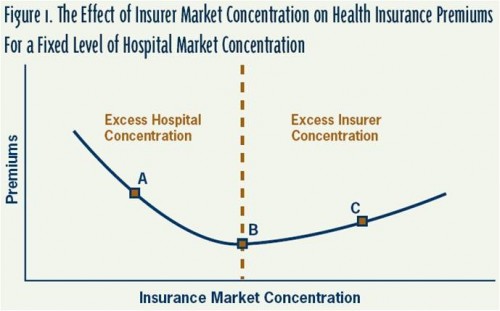Don’t let the title of the post scare you. Not yet, anyway. I’ll warn you when it is about to get frightening. Let’s begin simply.
Last November, the National Institute for Health Care Management foundation published a short paper by me that included the following chart.
Abut the chart, I wrote,
Understanding how hospital versus insurance concentration affects hospital prices and premiums is difficult due to the complex nature of price competition in the market for hospital services. A simplified picture of this complex relationship is illustrated in Figure 1, which shows how health insurance premiums in a market would be expected to vary depending on the “balance of power” between insurers and hospitals. This curve assumes a fixed level of concentration among hospitals so that the relative balance of power varies as insurer concentration changes along the horizontal axis. When insurance market concentration is low relative to that of hospitals (point “A”), the dominant hospitals can exercise market power and command relatively high prices from insurers, which are passed on to consumers in the form of higher premiums. As insurer concentration and relative power vis-à-vis hospitals increase (moving from point “A” toward point “B”), dominant insurers gain monopoly-busting power and can use the threat of network exclusion to negotiate lower prices and, thereby, offer relatively lower premiums. If, however, insurer market concentration far exceeds that of hospitals (point “C”), insurers can mark up the lower prices they obtain from hospitals and retain the difference as profit with little fear of losing enrollees to other insurers.
The rough shape of the curve illustrated in Figure 1 can be reproduced with formal economics models and features of it have been empirically verified by numerous studies.
You can find citations to those empirical studies in my NIHCM paper or any of a number of posts on this blog. What about the “formal economics models.” Actually, this is an area where theoretical work is scarce. I’m not a theorist so I can only speculate why. I think it’s because it’s because simple models, though easy to develop, do not capture what is most interesting about the relationships between hospitals and insurers.* I speculate that capturing the interesting stuff in a mathematically tractable way is too hard.
What’s most interesting is that both the hospital and insurance market is, in general, oligopolistic (includes a few competitors, so is far from perfectly competitive, though not monopolistic) and neither hospital services nor health plans are homogeneous products. That is, one hospital stay is not like another. One health plan is not exactly like another. Commodities markets–oil, milk, wheat, soybeans–are, in contrast, homogeneous, or nearly so. What sets hospital prices and contributes to premium levels is the interplay between these two markets, the bargaining for prices between each insurer on one side and each hospital on the other. Hence, “bilateral oligopoly” (to which I should add, but won’t belabor it, “with differentiated products”).
Is there a wealth of theory for such situations? If so, I’m not aware of it, and neither are a few theorists I’ve spoken to about this nor the authors of the latest empirical papers in this area (see links above). The authors explicitly state that theory is lacking here. They do so by way of justifying their use of measures in their models that really, strictly speaking, only apply in homogeneous product markets. If one assumes homogeneity of hospital services and insurance products, the theory is much easier. So easy that even I, a non-theorist, can make some progress with it.
But it is mathy and won’t interest most readers. I’ll provide it in a follow-up post. There will still be a little bit content for the mathaphobic so take a look before you decide it’s not for you.
*I’m abusing the term “insurers” here. I recognize that many plans serve as administrative intermediaries for self-insured firms. See this post for the semantic problems.



